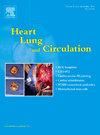法洛四联症修复后右心室恶化的快速进展和肺动脉瓣置换术的时机。
IF 2.2
4区 医学
Q2 CARDIAC & CARDIOVASCULAR SYSTEMS
引用次数: 0
摘要
背景:我们旨在确定修复法洛四联症(rTOF)的进行性表型,其特征是心脏磁共振(CMR)右心室(RV)参数的加速变化,并评估其与肺瓣膜置换术(PVR)加速过程的关联。方法:本研究是一项回顾性研究,研究对象为2005-2022年两次或两次以上cmr的rTOF患者。收集临床变量和CMR数据,计算CMR数据的年化变化。“快速进展者”被归类为年左室射血分数下降>3.5%或右室舒张末期容积指数(RVEDVi)增加>3.5 mL/m2。结果:共纳入112例rTOF患者(中位年龄14.7岁,63例男性),其中60例确定为快速进展(12例基于右心室射血分数,48例基于RVEDVi标准)。两组之间的基线RV体积和功能相似,尽管快速进展者的肺反流分数(PRF)更高(38.2±16.3 vs 31.4±15.4%;p = 0.033)。肺反流分数(PRF)(优势比1.03;95%置信区间[CI] 1.00-1.05;p=0.037)和左室舒张末期容积/左室舒张末期容积比(优势比2.75;95% ci 1.13-7.35;P =0.032)是快速进行性表型的显著预测因子。在随访期间(中位9.3年,四分位数范围6.8-13.8),48例患者接受了PVR。快速进展者发生PVR的风险增加了5倍(风险比5.44;95% ci 2.75-10.8;结论:本研究确定了rTOF亚群中更有可能发生早期PVR的成像生物标志物。本文章由计算机程序翻译,如有差异,请以英文原文为准。
Rapid Progression of Right Ventricular Deterioration and Timing of Pulmonary Valve Replacement in Repaired Tetralogy of Fallot
Background
We aimed to identify a progressive phenotype in repaired tetralogy of Fallot (rTOF), characterised by accelerated changes in right ventricular (RV) parameters on cardiac magnetic resonance (CMR) and assess its association with an accelerated course to pulmonary valve replacement (PVR).
Method
This was a retrospective study of patients with rTOF who had two or more CMRs (2005–2022). Clinical variables and CMR data were collected, and annualised changes in CMR data were calculated. “Rapid progressors” were classified as those with annual RV ejection fraction decreases>3.5% or RV end-diastolic volume index (RVEDVi) increases>3.5 mL/m2.
Results
A total of 112 patients with rTOF (median age 14.7 years, 63 males) were included, with 60 identified as rapid progressors (12 based on RV ejection fraction, 48 based on the RVEDVi criteria). Baseline RV volumes and function were similar between groups, although rapid progressors had a higher pulmonary regurgitant fraction (PRF) (38.2±16.3 vs 31.4±15.4%; p=0.033). Pulmonary regurgitant fraction (PRF) (odds ratio 1.03; 95% confidence interval [CI] 1.00–1.05; p=0.037) and RV end-diastolic volume/left ventricular end-diastolic volume ratio (odds ratio 2.75; 95% CI 1.13–7.35; p=0.032) were significant predictors of the rapid progressive phenotype. During follow-up (median 9.3 years, interquartile range 6.8–13.8), 48 patients underwent PVR. Rapid progressors had a five-fold increased risk of PVR (hazard ratio 5.44; 95% CI 2.75–10.8; p<0.001). Adjusting for age, sex, transannular patch use, baseline RVEDVi, and PRF, the risk of PVR remained over five-fold higher in rapid progressors (hazard ratio 5.18; 95% CI 4.39–5.97; p<0.001).
Conclusions
This study identifies imaging biomarkers in the rTOF subpopulation that were more likely to have an early PVR.
求助全文
通过发布文献求助,成功后即可免费获取论文全文。
去求助
来源期刊

Heart, Lung and Circulation
CARDIAC & CARDIOVASCULAR SYSTEMS-
CiteScore
4.50
自引率
3.80%
发文量
912
审稿时长
11.9 weeks
期刊介绍:
Heart, Lung and Circulation publishes articles integrating clinical and research activities in the fields of basic cardiovascular science, clinical cardiology and cardiac surgery, with a focus on emerging issues in cardiovascular disease. The journal promotes multidisciplinary dialogue between cardiologists, cardiothoracic surgeons, cardio-pulmonary physicians and cardiovascular scientists.
 求助内容:
求助内容: 应助结果提醒方式:
应助结果提醒方式:


